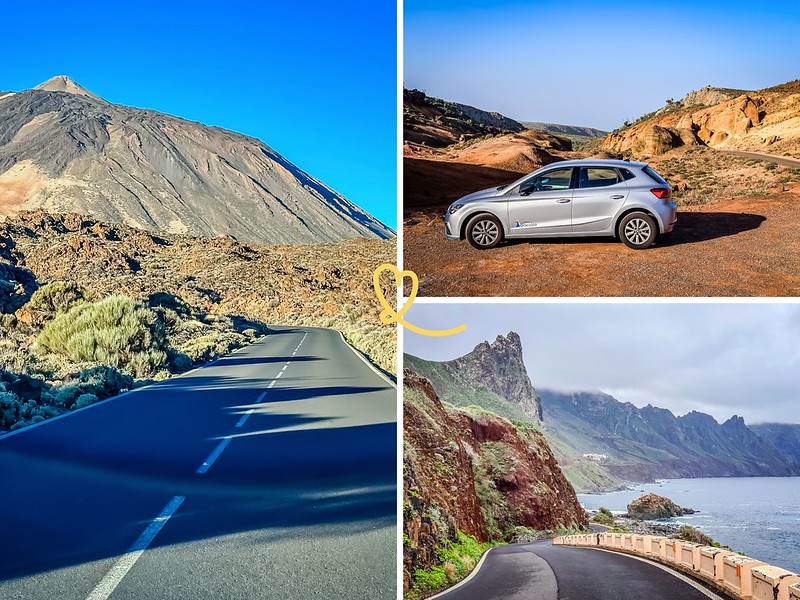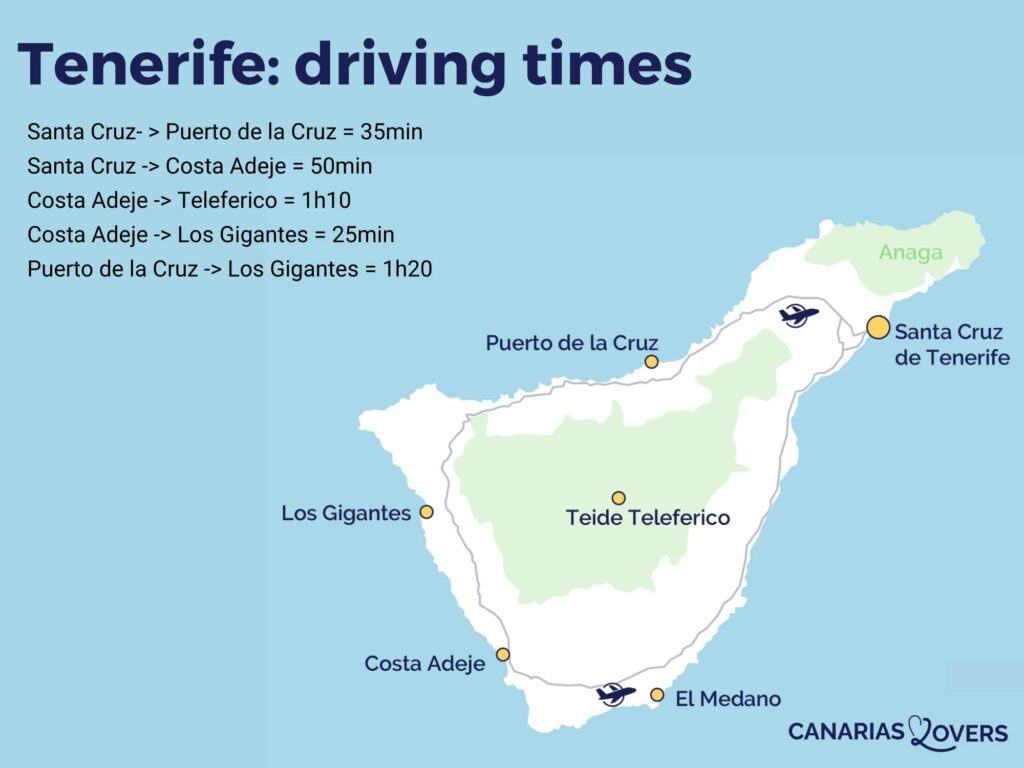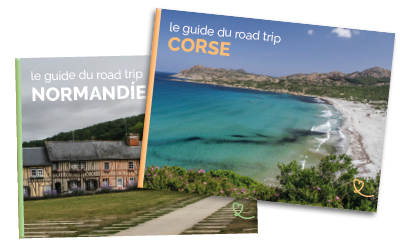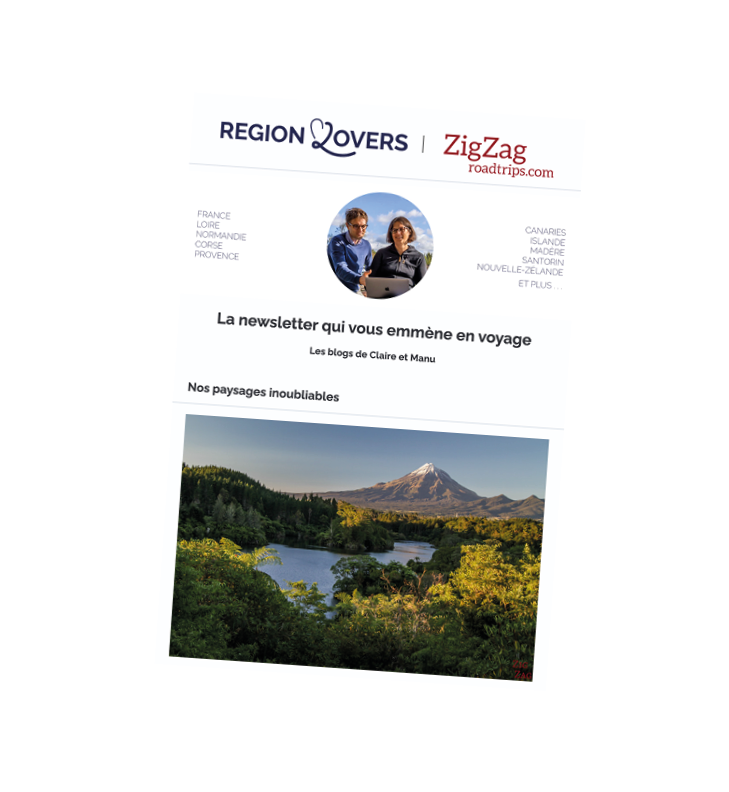Not to worry. Here’s our complete guide to driving in Tenerife:
- Safety and driving difficulties
- Rules of conduct
- Road conditions

This opinion is completely independent, based on our experiences. We visited the region anonymously, making our own choices and paying our bills in full.
Content
Driving in Tenerife: What you need to know
If you don’t want to read the whole article, at least read this short summary of the essential points to know:
- Minimum age 18, but some rental agencies may require drivers to be older.
- Driving on the right-hand side of the road
- Roads are generally in good condition. But on the western tip, there are some very steep roads.
- It is forbidden to wear flip-flops when driving (as in many countries, but more strictly).
- Locals can be impatient, so don’t forget to check your mirrors for passing locals.
- In case of accident – emergency number: 112
Here are the driving times in the region, to give you an idea of how to get around:

A LITTLE MORE patience
All the photos, maps, information and addresses you need to make your stay in the Canaries a success will soon be available in a single ebook!
If you’d like to be notified when our guide to the Canaries is published, please subscribe:

1. Rent the right car in Tenerife
To make driving easier, it’s best to choose a car adapted to the type of road and conditions. In the case of Tenerife, we recommend:
- Not too big, as some roads are narrow
- A good engine, because there are mountains, and some roads are really steep.
- Automatic if possible, as the roads are winding and require constant gear changes.
Find out more in our article: how to rent a car in Tenerife.
>> See car rental offers on our preferred platform

2. Know the rules of conduct
Permit requirements
To drive in Tenerife, or in Spain, you need a valid driving license from your country.
If you have a valid driver’s license, which includes: license number, photo, validity date and is written in Latin letters, then you don’t need an international license.
Otherwise, you’ll need to bring along an international Driving License.
Age
You must be at least 18 years old.
But be aware that many rental companies may have other age requirements, often 21.
General rules
- In Tenerife, we drive on the right-hand side of the road.
- Seat belts mandatory for all
- No cell phones while driving
- Headphones are forbidden
- Children under 12 are not allowed to sit in the front of the car.
- Don’t wear flip-flops when driving

Alcohol and driving
The legal alcohol limit here is 0.05%. Driving under the influence is considered a serious offence.
We always recommend not drinking at all if you’re driving.
Mandatory in-car equipment
In Tenerife, the following equipment must be available in the car (as in Spain):
- 2 warning triangles
- Reflective vest or jacket
- Spare wheel and tools for changing it
- First-aid kit (recommended, not mandatory)
- Flashlight (recommended, not mandatory)
- Children weighing less than 18 kg must be placed in child seats.
- Children under 135 cm tall must be seated on a booster seat in the rear seats.
Compulsory insurance
The only compulsory insurance in Tenerife is unlimited third-party insurance – automatically included in the price of all car rentals.
If you’re bringing your own car, don’t forget to bring proof of insurance.

WHERE TO STAY IN Tenerife
Our independent picks for the accommodation of your dreams:
- Where to stay in Tenerife
- Our favorite: Hotel Corales Beach
Select by hotel type:
- 5-star hotels
- Best boutique-hotels
- Best adults-only hotels (coming soon)
- Best all-inclusive hotels (coming soon)
- Best hotels for families (coming soon)
Select by city:
- Best hotels in Costa Adeje
- Best hotels in Puerto de La Cruz
- Best hotels in Los Gigantes
- Best hotels in Santa Cruz
- Best hotels in Laguna
- Best hotels in Playa de las Americas
- 5-star hotel in Los Cristianos (coming soon)

3. Preparing for different types of road
Fast roads: the coastal ring road
TheTF-1 and TF-5 roads are considered to be freeways.
They link the capital, Santa Cruz de Tenerife, with the south coast (towards Costa Adeje and Los Gigantes) and the north coast (towards Puerto de la Cruz).
This ring road currently covers 75% of the perimeter.
These roads offer excellent surfaces and higher speeds.
They’re free and easy to drive.

Mountain roads
There are two types of mountain roads:
- those that go up to Teide National Park from the big cities. They are winding but very easy and wide.
- those at the western tip (around Masca and Buenavista del Norte) and eastern tip (Anaga rural park), which are very winding and sometimes very narrow, and considered the most difficult on the island. If you choose to go, we advise you to leave early to avoid traffic.

In the cities
The streets of Tenerife’s towns are quite typical. In cities, you’ll encounter more traffic, crosswalks and parking problems.
No major difficulties apart from Icod de los Vinos, which has very steep roads and tourist buses. It’s not the most pleasant to drive.

In the villages
For villages, we advise you to use outdoor parking, and not to try to get in by car, as some streets can be narrow.
Unsealed roads
There are very few unpaved roads, mainly a few parking areas.

HAVE FUN IN TENERIFE: activities

4. Understanding signs and tolls
Speed limits
- Speed limits are indicated on circular signs with a red border and a number
- Speed limits are expressed in kilometers per hour
- National speed limits are: 50km/h in residential areas, up to 110km/h on main roads.
Road signs
Road signs are classic, in Latin letters, so there’s nothing specific you need to know.
There are lots of signs pointing the way.
Points of interest are indicated on brown signs.
Tolls
There are no toll roads.
Subscribe to our Newsletter
- Get away from it all with Region Lovers’ beautiful destinations!
- Once a month
- Advertising-free
5. Safety: understanding potential hazards
Is driving in Tenerife dangerous?
No, on the whole, driving in Tenerife is not dangerous.
There may be a few minor challenges, especially on some narrow, winding mountain roads. However, the island is generally safe for drivers, with good road conditions. It is essential to respect speed limits and remain vigilant, especially in tourist areas.
And to make mountain roads easier, start your day early to reduce traffic.

Potential hazards
- Landscapes –
The main danger is that you’ll be distracted by the stunning scenery. - The premises –
Because you want to look at the scenery, locals on their way to work can be impatient. They can be a bit crazy when overtaking. So always look in your rear-view mirror. - Cyclists –
Especially at weekends, be very careful when overtaking. - Animals –
As everywhere, especially at dawn and dusk, animals can cross the road. - Rockfall –
Mountains mean possible rock falls on the road

What to do in the event of an accident
If people are injured or there is a conflict, the emergency number is 112 (with operators who speak European languages):
The best order of action is
- contact the emergency services
- contact the police
- contact your rental provider
6. And the rest: parking, fuel…
Fuels and service stations
- Fuel is considered cheap compared to the rest of Europe
- The Spanish word for service station is “estación de servicio”.
- Gasoline is found on the green pump – called “gasolina” and if unleaded “gasolina sin plomo”.
- Diesel is found on the black pump called “gasoil”.
- There aren’t many electric recharging stations available at the moment.

Parking in town
In cities, the easiest way is to use the parking areas or underground parking lots, as it’s often difficult to find parking in the city center. Parking is not free.
If your hotel is in the center of town, find out about parking conditions.
If it’s high up in a valley, it should be easy to park on the street.

Parking at beaches and attractions
Around the main attractions, we found the parking lots to be quite small. They fill up quickly.
For example, the different viewpoints in Teide National Park. We recommend arriving early to find a seat.
Tenerife’s most beautiful roads
In our opinion, the most beautiful roads on Tenerife are..:
- The road through Teide National Park (TF-21 center)
- The Masca road (TF-436 south)
- The road through Anaga (TF-12)
- Anaga North Road (TF-134)
- The road around Vilafor (TF-21 south)
- The road down from Teide to the west (TF-38)
- The Punta de Teno road (TF-445)
- The Buenavista del Norte road (TF-436 north)
See our more detailed article on Tenerife’s most beautiful roads (coming soon).

Frequently asked questions
Do you need a car in Tenerife?
It all depends on what you want from your vacation…
To see a little of the island: We strongly recommend taking a car. This allows you to discover much more of the island’s magnificent scenery in all its nooks and crannies.
But if you want to enjoy the beach close to your hotel, and visit only a few of the most famous places, you can choose accommodation in one of the southern resorts and join organized tours or cab tours.
Is it necessary to rent a 4WD vehicle in Tenerife?
There’s really no need to rent a 4WD in Tenerife. The roads are almost all paved and in good condition.
There are very few opportunities for 4WD exploration on trails.
PLAN YOUR TRIP TO tenerife
- Best of
What to do in Tenerife
Most beautiful towns and villages
Most beautiful beaches
Best natural pools
Most beautiful landscapes
Most beautiful roads
Amusement parks
Best boat tours (coming soon)
Secret places, off the beaten track (coming soon)

- Practical advice
25 tips for a successful trip to Tenerife
How to get around
How to rent a car in Tenerife
Driving tips
Best excursions (coming soon)
Where to stay in Tenerife
Itineraries: 3 days – 4 days – 5 days – 6 days – 1 week – 10 days

- The must-dos
Dolphin watching in Tenerife (coming soon)
Teide National Park
Anaga Rural Park (coming soon)
La Orotava (coming soon)
Garachico
Village of Masca
Pyramids of Güimar




